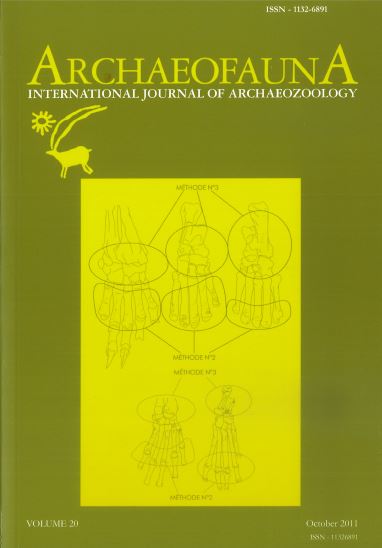Micromamíferos (Erinaceomorfos y Roedores) del final del Pleistoceno superior y primera parte del Holoceno de Cova Fosca (Alto Maestrazgo, Castellón): Reconstrucción paleoambiental del entorno del yacimiento
Keywords:
Micromammals, Erinaceomorphus, Rodents, Final Pleistocene, Early Holocene, Cova Fosca, Castellón, SpainAbstract
This work describes the erinaceomorphs and rodents from the Late Pleistocene- Middle Holocene site of Cova Fosca. The data presented derive from the excavations carried out from 1999 to 2003 at the entrance of the cave. The micromammal taxa identified in the Early Neolithic (6.230-6.200 BP), Mesolithic (10.020–8.880 BP) and Epipaleolithic (19.920-12.130 BP) levels include one erinaceomorph species (Erinaceus europaeus) and five species of rodents: Eliomys quercinus, Sciurus vulgaris, Apodemus sylvaticus, Microtus cabrerae and Microtus duodecimcostatus. The latest level of the Middle Neolithic is essentially sterile incorporating three dental remains of Microtus sp. The wood mouse, Apodemus sylvaticus, is the most abundant species with MNI percentages that oscillate between 35% and 63%. The small mammal association indicates a woodland landscape with open spaces and plenty of wet meadows with herbaceous and shrub vegetation. Weather conditions would have been of temperate and humid Mediterranean type, with higher humidity than that present today around Cova Fosca. Almost all of the recorded taxa presently live in this area. The exception is Microtus cabrerae, missing from almost the entire Mediterranean region except for some areas of the Sierras Béticas and the Southern Sistema Ibérico. Still, there are many finds from this species in Upper Pleistocene and Holocene deposits of the Levantine region, as well as of its Middle Pleistocene ancestor species, Microtus brecciensis, reported in the entire Mediterranean region from Gibraltar to the north of Catalonia. The presence of Microtus cabrerae at Cova Fosca enlarges our knowledge of the distribution of the species at the end of the Upper Pleistocene and earlier part of the Holocene in the Mediterranean region. Its present day absence coincides with the retraction that Microtus cabrerae suffered since the end of the Pleistocene, with a virtual disappearance from the Mediterranean region. This was possibly due to the onset of more arid conditions, that the changes experienced by the micromammal fauna since the Upper Pleistocene in the Mediterranean region and southern Spain first noted by Sesé (1994), indicate. The association at Cova Fosca evidence that notable differences existed between the small mammal faunas of Northern Iberia and those of Mediterranean region during the Upper Pleistocene and Holocene. These reflect the differences in climate and landscape, being the north, then as now, more humid and with a wider range of biotopes. In the Mediterranean region there was a lower faunal diversity with species of Mediterranean climatic requirements being often dominant, as was the case at Cova Fosca. From a taphonomical standpoint, the reported accumulations were very possibly the result of the activities of preybirds. This work also contributes to the knowledge of the small mammals from the Upper Pleistocene and Holocene in the Levant region of the Iberian Peninsula, in that it is the only site with fauna of these ages reported thus far for the province of Castellón.

